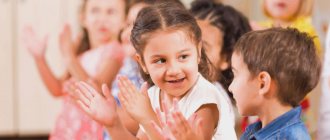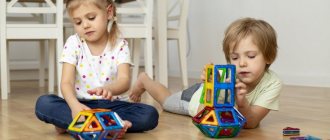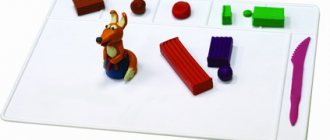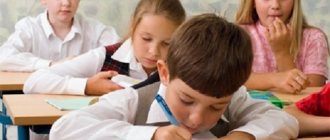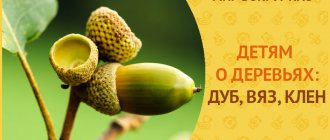Literary quiz for the preparatory group of preschool educational institutions
Experts in the preparatory group will easily cope with the prepared questions, and the quiz is an interesting format of tasks to arouse in students a love of literature. The main rule is to answer correctly. For fun, you can combine players into teams.
Educational quiz for the younger group
Beyond time, basic questions remain, the answers to which children know based on daily communication with peers and parents.
- What do you call a child who is smart beyond his years? (Prodigy)
- What is between night and day? (Morning)
- What color are the first flowers after winter? (White)
- What does frost paint on the windows? (Patterns)
- Jewelry for fingers is... (rings)
- What do they twist around the waist during sports activities? (Hoop, hula hoop)
- Who heals people? (Doctor)
- Who does dental treatment? (Dentist)
- How, besides money, can you pay for purchases? (Bank card)
- Where can I withdraw money from my card? (At the ATM)
- What is the name of the online world of computer games? (Virtual)
- What is the main attribute in football? (Ball)
- When do children go to school? (September 1)
- How many numbers are there in total? (10)
- Where do they perform in performances and concerts? (On the stage)
Development of logic and thinking
Logical thinking is very useful for a child from the very first days of school. Logic helps to solve various problems, including mathematical ones. Having this knowledge, the child will feel much more confident in life, learn to think, look for patterns, and draw conclusions. It is advisable to start with the simplest exercises, gradually complicating them.
Analogies
The purpose of this task is to teach the child to establish a logical connection between words, train flexibility of thinking and draw analogies. To do this, you need to divide a sheet of paper into two columns, and write a few words in each column. Then you need to invite the child to study the words in the right column and establish a logical connection between them.
When the child understands what the words in the right column have in common, he should be asked to study the words located in the left column and choose from them those words that match the words from the right column.
The main thing is that the child can explain why he chose this particular word and what unites all the words he chose.
For example, in the left column the words are given: currant, berry, pan. The words in the right column are: stove, soup, spoon, dishes, cook. The word “saucepan” fits the words from the right column, since this is a dish, it sits on the stove, in which the cook cooks soup and stirs it with a spoon.
Eliminating unnecessary things
The purpose of this task is to teach the child to generalize and classify various concepts. The child must be offered a list of words (at least 4), of which one word does not fit in meaning with the others. The kid must find the extra word and explain why he chose it. The child needs to complete about 10 tasks at a time.
For example, the words are given: shoes, boots, boots, sandals, felt boots, laces. In this series, the word “laces” is superfluous, because these are not shoes.
Speed of thinking
This task teaches the child to see the whole picture as a whole, to put together a complete image from details. The purpose of this exercise is to train your thinking speed.
The child needs to be shown words whose letters are missing. In place of the missing letter there is a dash; the number of dashes is equal to the number of missing letters. In three minutes, the child needs to form as many words (singular nouns) as possible.
It’s not scary if the baby doesn’t understand what word can be formed from the remaining letters. You can skip this word and move on; the main thing here is not only correctness, but also speed.
For example, on paper it may be written: g-ra, z-m-k, r-ba, o-n-. The child must name the words as quickly as possible: mountain, castle, fish, window.
Decoding anagrams
Anagrams are words whose letters are rearranged in random order. The child must identify the encrypted word. This task helps the child see the whole picture from the details.
For example, a child is shown a card on which it is written: chnetie, slot, aogvolmolko. The child must guess as quickly as possible that these are the words reading, table, puzzle.
Music quiz for the senior group of kindergarten
The love of music must be cultivated in childhood. Knowledge of tools and basic terms indicates the general intellectual level of a person. We have prepared 15 thematic questions for preschool children.
- What is a geometric musical instrument called? (Triangle)
- Who runs the orchestra? (Conductor)
- Each song has a verse and... (chorus)
- What do you call a dancing group on stage with a performer? (Backup dancer)
- A device with which you can listen to music on public transport without disturbing others? (Headphones)
- What is the name of the famous Christmas ballet? (Nutcracker)
- What was the name of the deaf-mute composer? (Beethoven)
- The simplest Russian folk instrument with three strings is... (balalaika)
- Whoever sings on stage alone is called... (soloist)
- The popular European song contest is... (Eurovision)
- When ten guys sing together, they sing... How? (in chorus)
- Music without words for a performance is called (Backing Track)
- What do they film on Tik Tok accompanied by famous songs? (Trends)
- Who sang the song on the ice floe? (Baby Mammoth)
- Continue: the circle of the sun, the sky around, this is a drawing... (boys)
Exercises on Russian language and speech development
Developmental tasks for children 6-7 years old must necessarily include exercises in the Russian language and speech development. At this age, a child must know the alphabet, be able to put letters into words, be able to write (in block letters), and also be able to clearly, distinctly and relatively competently express his thoughts and opinions.
To study the alphabet, you can use cubes, special cards with words and letters, cards with pictures, and printouts with ready-made small exercises.
Missing letters
The child needs to print pictures of animals and objects with their names on a sheet of paper. In names, several letters must be omitted. The kid must understand who is located in the picture and fill in the missing letters in the words.
For example, on the left side of the sheet you can place a drawing of a dog, and on the right side you can place the inscription “s... b... ka.” The child can fill in the missing letters “o” and “a” right there on the sheet with a pencil or pen. At one time, the child must complete about 10 such tasks.
Unravel the words
You need to print the pictures on a sheet of paper and sign them, mixing up the letters. The child needs to guess which word is encrypted under the picture.
For example, under a picture of a chamomile, you need to sign “daisy”. This exercise trains attentiveness and intelligence, and also helps the child navigate how words are constructed.
Speech development exercise
This developmental exercise for children 6-7 years old is performed in the form of a conversation. The child needs to be asked a number of questions in order to clarify his ideas about a particular subject. For example, you can ask about what you can do at the table and why it is needed. The child must tell him that he can sit, eat, play, and read at the table. This way you can describe any objects.
You should ask your child what a scooter, a meat grinder, an airplane, a vacuum cleaner are. The child must guess why these items are called that way and explain why they are needed and how people use them. The baby should be able to generalize objects, for example, a table and a chair are furniture, and a lion and a cat are animals.
It is advisable to talk with your child more often and ask his opinion on any issue - the answer does not have to be correct , the child will show his imagination and make his own assumptions. The main thing is to teach your child not to be afraid to speak out.
Developmental exercises for children 6-7 years old allow parents to prepare their child for school without stress and additional costs for tutors. Completing the assignments will not take much time and will help your child gain basic skills for further study at school.
Quiz about cartoons for 5 years old
With the help of a quiz it is easy to check how well children know the plot of cartoons and what they pay attention to. In addition to the proposed questions, children can be read a description of the cartoon - and they must say its name themselves or choose from interesting options.
- What cartoon was Princess Jasmine in? (Aladdin)
- How many robbers have stood up to Alibaba? (40)
- What was the name of the hippopotamus from the cartoon Madagascar? (Gloria)
- The big green character who lived in the swamp is... (Shrek)
- Who is always in a hurry to help? (Chip and Dale)
- How many nephews did Scrooge McDuck have? (Three)
- What was the name of the disgruntled octopus, SpongeBob's acquaintance? (Squidward)
- In which cartoon do puppies come to the rescue? (PAW Patrol)
- How many Dalmatians were there in the popular cartoon? (101)
- What was the name of Cheburashka's best friend? (Crocodile Gena)
- The name of the horse from the cartoon about 3 heroes... (Juliy)
- Who can move around the city on a web? (Spiderman)
- What was the name of the moose from Smeshariki? (Losyash)
- What is the name of the cartoon where a squirrel tried to get a nut out of ice? (Glacial period)
- What was the name of the big black cat from the cartoon about Mowgli? (Bagheera)
General principles of organizing classes
Developmental tasks for children 6-7 years old should be carried out daily. At the same time, it is important that the child does not get tired and is motivated to study. Often children lose attention and quickly get bored with everything. It is important to interest the child and make the learning process easy and enjoyable. This way the classes will be more fruitful and effective.
It is important to follow a few simple techniques for teaching your child:
- Don't chase the perfect result. Each child perceives this world differently. Each child has his own abilities, some love to learn new things and quickly absorb the necessary knowledge, while for others learning is difficult and does not arouse any interest. It is important not to give up, not to scold your child and not to compare him with other children. Constant dissatisfaction, reproaches and screams will only hurt the child and develop an inferiority complex. This will discourage all desire to study further; the entire process of preparing for school will be painful for the child. The main thing is to make it interesting and fun for the baby.
- Communicate a lot with your child . You need to constantly be interested in the child’s opinion, let him not be afraid to speak out on any occasion. The child should be able to express his opinion about the book he read or the cartoon he watched. If it is difficult for a child to do this, it is worth asking a couple of leading questions or suggesting what exactly the author of the book or cartoon had in mind. It is important not only to be able to retell your favorite cartoon, it is important that the child is able to analyze and draw conclusions about a particular character or a particular situation.
- Turn learning into a fun game. Even math can be fun if you do it with your favorite toy. You can, for example, “feed” a teddy bear with apples or other fruits. For example, you can offer a bear two apples and three bananas for breakfast. In this way, you can teach your baby to count to ten and even add. While walking, you can count puddles, clouds or birds. You can ask your child to read street names or house numbers. Such a walk will be interesting and useful.
- Make crafts and applications . Children love to draw or sculpt from plasticine; this not only develops fine motor skills, but also helps them learn the names of colors. Various elements for applique can be arranged by color, and then count how many elements of a particular color are obtained.
- Teach your child basic safety rules . At this age, the baby should already know his last name, first name and patronymic, his address, and also know the safety rules on the street and at home.
- Develop the child harmoniously . Each child has his own abilities, some like to solve math problems, while others prefer to read books. It is important to pay more attention to those tasks that the child does worse.
It is important to accustom your child to a certain daily routine, so it will be easier for him to get used to school rules. Classes should be held at the same time, so the child will feel calmer. After classes, it is important to give the child a rest and do something he loves - watch cartoons or take a walk on the playground.
The duration of classes should be no more than half an hour a day. Too long and tedious lessons will tire the child, he will lose interest in the subject being studied.
It is important to alternate classes so that the baby does not get bored. It is better to take a short break between classes, during which the child can draw, run or eat something tasty.
For 6-year-old children, preparatory classes should last no more than 25 minutes. per day and no more than 2 times a week. At the age of 7 years, you can study 3 times a week for half an hour a day. It is important to correctly schedule classes, taking into account the individual characteristics of the child.
It is best to practice in the morning. The emphasis should be on those tasks that the child does worst. These are the tasks that need to be worked on more often and for longer.
It is advisable to carry out developmental tasks for children 6-7 years old according to the schedule:
| Job type | Class schedules by day of the week | ||||||
| Mon. | Tue | Wed. | Thurs. | Fri. | Sat. | Sun. | |
| Logic tasks: | |||||||
| analogies | 7 min. | 5 minutes. | |||||
| eliminating unnecessary things | 7 min. | 10 min. | |||||
| speed of thinking | 3 min. | ||||||
| deciphering anagrams | 10 min. | ||||||
| Mathematics: | |||||||
| learning counting | 10 min. | ||||||
| simple geometry | 5 minutes. | ||||||
| say it right | 3 min. | 3 min. | |||||
| Russian language exercises: | |||||||
| missing letters | 7 min | 7 min. | |||||
| unravel the words | 5 minutes | 5 minutes. | |||||
| speech development exercise | 10 min. | 10 min | |||||
It is important to properly equip the place where classes will take place for your child. The baby should feel as comfortable and comfortable as possible. It is advisable to place your favorite objects and toys nearby.
It is very important to properly equip a table for a future first-grader. A comfortable table will protect the baby’s spine from curvature, and will also help protect the child’s vision.
It is important that the child is comfortable at the table. If a child is uncomfortable in his workplace, he will not be able to concentrate properly on doing the exercises.
There are several rules regarding the size of a desk. It will be enough for a 6-year-old child if the height of the table is 45-48 cm, but later you may have to replace the table with a higher one or immediately choose an option with an adjustable height. The depth of the working surface of the table should be 80 cm, and its width should be 160 cm.
It is best to take your child with you to a furniture store and choose a table that suits his height and taste. A suitable table should reach the chest height of the baby sitting at it. In this case, the legs should be placed on the floor at a right angle and should not touch the tabletop from below. It is best to choose a table made from natural materials.
The child must also choose a chair for his workplace; it must be beautiful, comfortable and suitable in size for the table. You should not choose a chair that is too large; the child should be able to sit comfortably during classes. It is best to place the table and chair near the window, but not opposite it, as the child will be distracted from his studies, constantly watching what is happening on the street.
It is important to choose high-quality lighting so that there is no risk of deterioration of the baby’s vision.
It is best to choose several light sources with different brightnesses. In this case, at any time of the day, you can choose the ideal lighting that will not softly illuminate the work area, but will not blind the child’s eyes.
The child’s workplace should be beautiful and tidy. It is important that the child enjoys being there and tries to keep his workspace clean. It is best to teach your child how to properly organize all his things before school.
Let him choose a place to store his pencils, markers, plasticine, notepads and notebooks. All accessories should be put away in the desk drawer, and the tabletop itself should be empty, with the exception of small decorative items (for example, a small toy).
Riddles for the development of thinking of 5-6 year olds
The purpose of riddles is not just to formulate questions on a certain topic, but also to have fun. We have selected the top 15 interesting tasks for kids that can test their general knowledge.
- Jumps through the trees and hides nuts. (Squirrel)
- A faithful friend for a person, will become a running companion. (Dog)
- A fluffy ball, a ball of wool. Drinks milk and purrs easily. (Cat)
- The nose is a snout and the tail is a hook. (Pig)
- Butts and jumps, hides a lot of fur. (Goat)
- I am stubborn, small, related to any horse. (Donkey)
- It takes five hours for me to crawl a step. (Turtle)
- Throw in meat, onions, potatoes. Eat the pan, not the spoon. (Soup)
- Striped, scarlet, everyone loves me very much. (Watermelon)
- Not an easy neighbor, but a real mother hen. (Chicken)
- A beep will notify everyone when there is boiling water. (Kettle)
- A stick with a thread and a hook, with it you will be a fisherman. (Fishing rod)
- It drives and buzzes, in a hurry to take everyone home. (Car)
- Let's go on a trip and put at least a bear there. Small and large, they store expensive things. (Suitcases)
- We put the earhooks on the small ears. (Glasses)
Math classes
Developmental tasks for children 6-7 years old must necessarily include math exercises. At this age, the child should already have a good knowledge of forward and backward counting to 10, understand the operations of increasing or decreasing, and be able to restore the sequence of numbers if one or more numbers are missing.
The child also needs to be taught to compare numbers; he must understand concepts such as “more”, “less” or “equal”. It is also important to be able to compare objects by length, width and height, as well as know the name of geometric shapes.
Learning to count
On a piece of paper, write a number series with missing numbers. The child's task is to fill in the empty cells with the appropriate numbers. For example: 2, …, …, …, …, 7, 8, 9, 10; 6, …,…,…,10.
It is advisable to complete about 10 such tasks at a time. In this case, it is desirable that different numbers be skipped each time. It is important to teach your child not only to count forward, but also to count backwards. You can ask your child to fill in the blanks for numbers from 10 to 4 or from 6 to 2. All tasks should be different. It is important that the child be able to reproduce a sequence of numbers, starting from any number.
Simple geometry
This exercise helps the child learn simple geometric shapes, helps to understand what width, length or height is, and develops imagination and spatial thinking.
The child needs to be shown a sheet of paper on which different geometric shapes are located. The child should be able to find a square, circle, triangle, oval, trapezoid and parallelepiped in a picture. It is important that the baby understands which of the figures is larger, taller, wider or longer.
You can cut out different shapes from colored paper and invite your child to sort them by size, color or name, and then count which shapes there are more and how much more. This task helps you learn to categorize objects and analyze the results.
Say it right
This exercise is carried out in the form of a game. The child must be asked 10 questions about mathematics. In the allotted time, the child must give as many correct answers as possible.
Examples of questions for the game:
- Name the neighbors for the number 4.
- What number is 1 greater than 3?
- Name the numbers from 4 to 9.
- Name the days of the week from Thursday to Thursday.
- How many days are there in a week?
- How many months are there in a year?
- Name the fifth month of the year.
- Name the third month of the year.
- Say the numbers in reverse order from 10 to 5.
- Decrease the number 4 by 2 units.
To make it more interesting, you can come up with special prizes for your child for winning (candies or small toys). For example, for 8 correct answers the prize will be candy, and for 10 correct answers a small toy.



